6 Tips to Help You Achieve Your Procurement Goals


Hitting those procurement targets is a big deal for any organization.
After all, it makes all the difference between efficient operations and lost opportunities.
But that doesn’t mean that this is a walk in the park. Without a plan and straightforward process, it’s easy to get stuck in a cycle of frustration and missed goals.
If you’re tired of spinning your wheels, this article is for you.
We’ll walk you through everything from defining your goals and building a high-performing team to implementing Agile methodologies and tracking the metrics that matter.
By the end, you’ll have a clear roadmap to procurement success.
So, let’s get into it.
It may be tempting to skip this step, and you may believe that your procurement goals are already well-defined.
But let’s briefly pause and reassess.
A lot of procurement teams struggle because they’re chasing vague targets. If you can’t measure it, you can’t manage it, right?
Clear goals are like a North Star for your team.
When everyone knows exactly which direction they’re headed in, it’s easier to get there.
Plus, when each team member has a precise understanding of the desired outcomes, they can focus their efforts on activities that directly contribute to them.
So, what makes a good goal?
Take a look at the visual below, breaking down the difference between a non-SMART and a SMART goal.
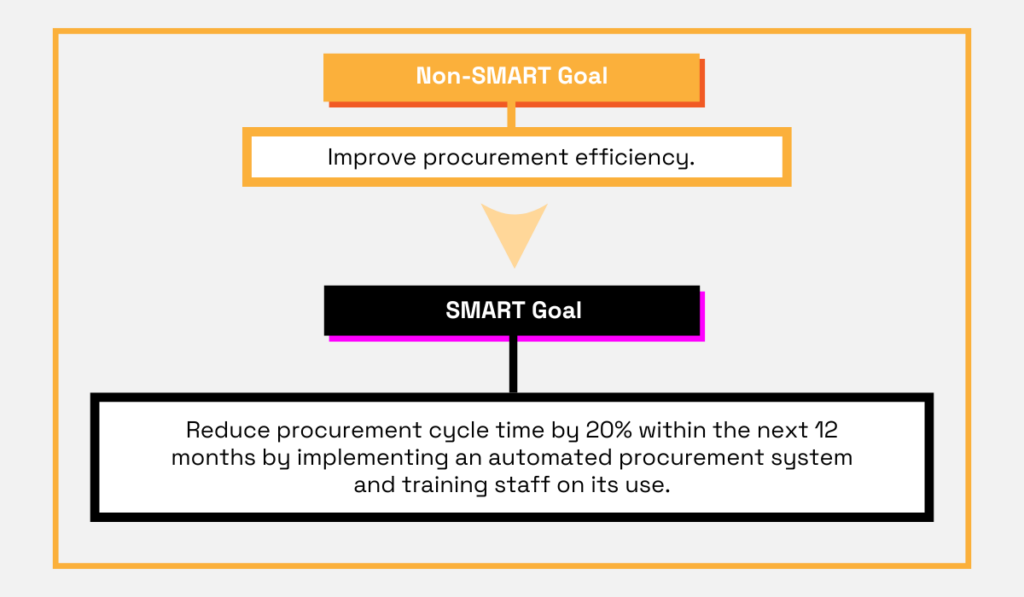
Source: Veridion
As you can see, the first goal is vague, general, and unmeasurable.
In other words, it doesn’t give any specific criteria or metrics that guide efforts.
The second one, however, follows the SMART framework:
| SMART Aspect | Explanation |
|---|---|
| Specific | Clearly defines what needs to be achieved. |
| Measurable | Includes criteria to measure progress. |
| Achievable | The goal is realistic and attainable given the available resources. |
| Relevant | The aim aligns with broader business objectives. |
| Time-bound | There’s a clearly defined timeframe for completion. |
To help you create such goals within your own organization, let’s further break down the example of a SMART goal we outlined earlier:
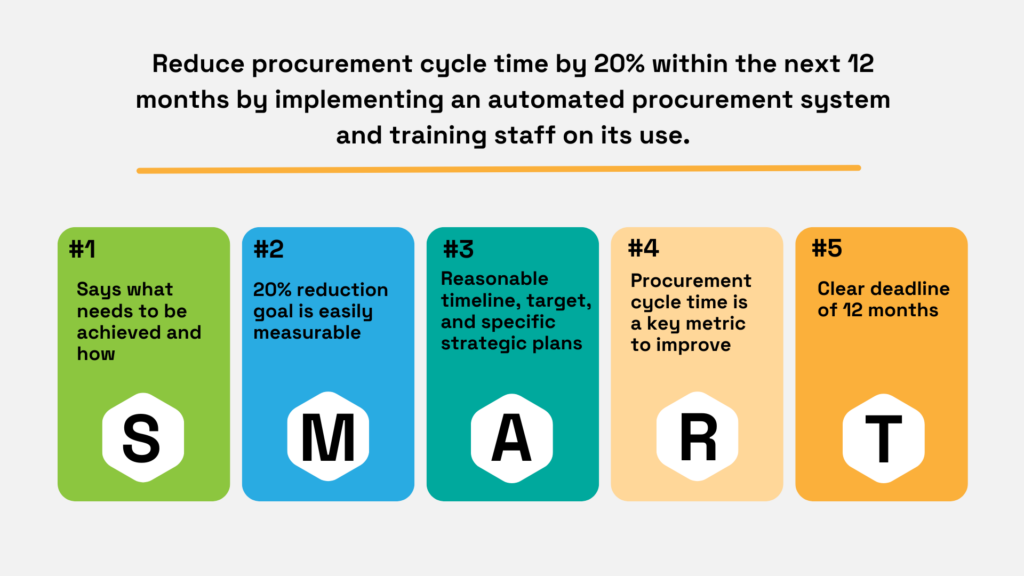
Source: Veridion
The Specific aspect concerns both what needs to be achieved, like “reducing the procurement cycle by 20%,” and how to achieve it, such as “by implementing an automated procurement system and staff training.”
The goal itself is Measurable by tracking the procurement cycle time, which is also a Relevant metric for procurement operations.
The 12-month timeframe means the goal is Time-bound, and, given the specific strategy included in the goal, we can reasonably say it is also Achievable.
So, review and refine your goals using the SMART framework.
Break down any large, vague goals into highly specific milestones, and you’ll be on your way to achieving them.
Our next tip is to use automation to improve your procurement operations.
Procurement automation tools can handle tedious, repetitive tasks, completing them faster and with fewer mistakes than their human counterparts.
This gives your team time to focus on bigger-picture things and more important work.
There are many systems that have automation features.
But before we dive into the specifics, below is a breakdown of the main types of automation technologies you should be on the lookout for.
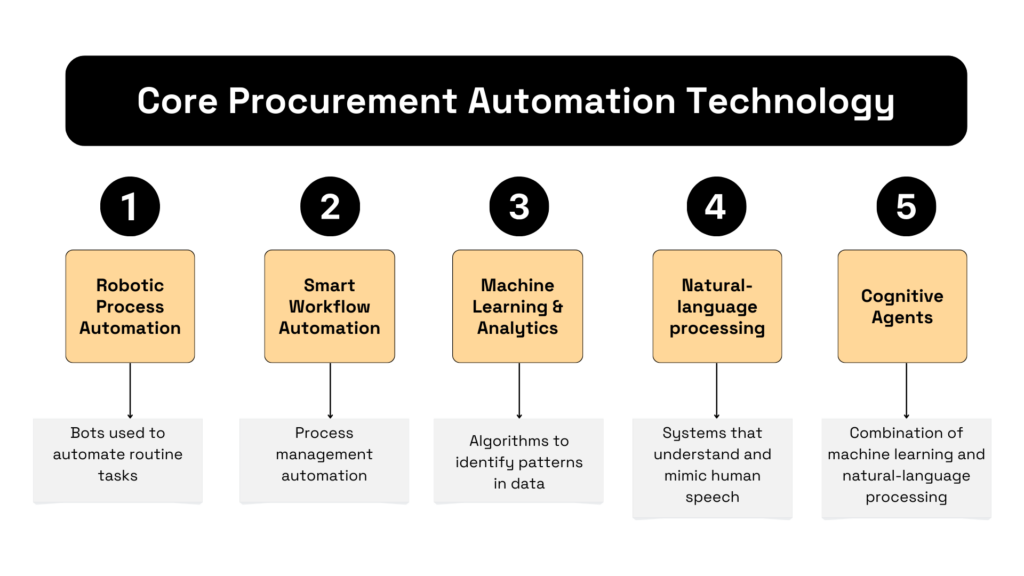
Source: Veridion
Let’s illustrate how these can be used with an example.
Robotic Process Automation (RPA) can automate routine tasks in procurement, such as invoice processing, purchase order creation, and data entry.
RPA uses software robots, or “bots”, to perform these tasks just as a human would, but much faster and without mistakes.
More recently, with machine learning and natural language processing in the mix, we’re looking at tech that can understand and respond to queries, analyze data, and generate new insights.
These technologies can handle trickier tasks like picking suppliers and assessing risks, making your procurement process smarter and more responsive.
So, what kind of tools use this kind of tech?
To get a detailed overview, check out our article on the topic, which includes tools like:
One area where automation really shines is supplier selection.
Take Veridion, for example—our supplier sourcing enabler tool that combines machine learning and AI with a massive database of over 80 million suppliers.
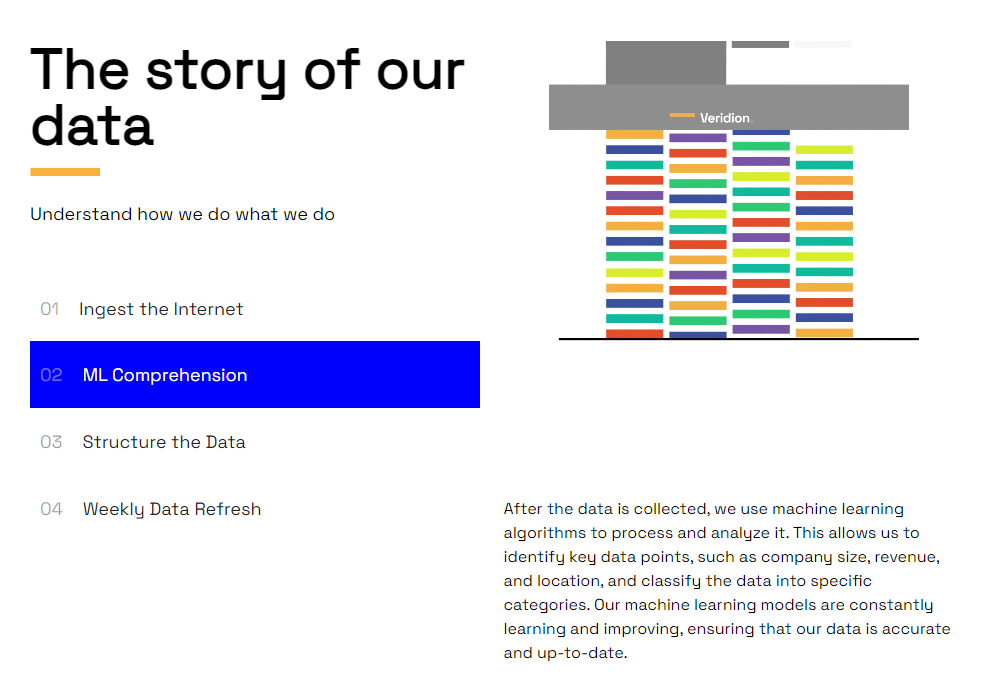
Source: Veridion
Our algorithms constantly check and analyze data, looking at important supplier information and keeping the database up-to-date.
To use this structured data, just use our Search API and type in what you need using natural language.
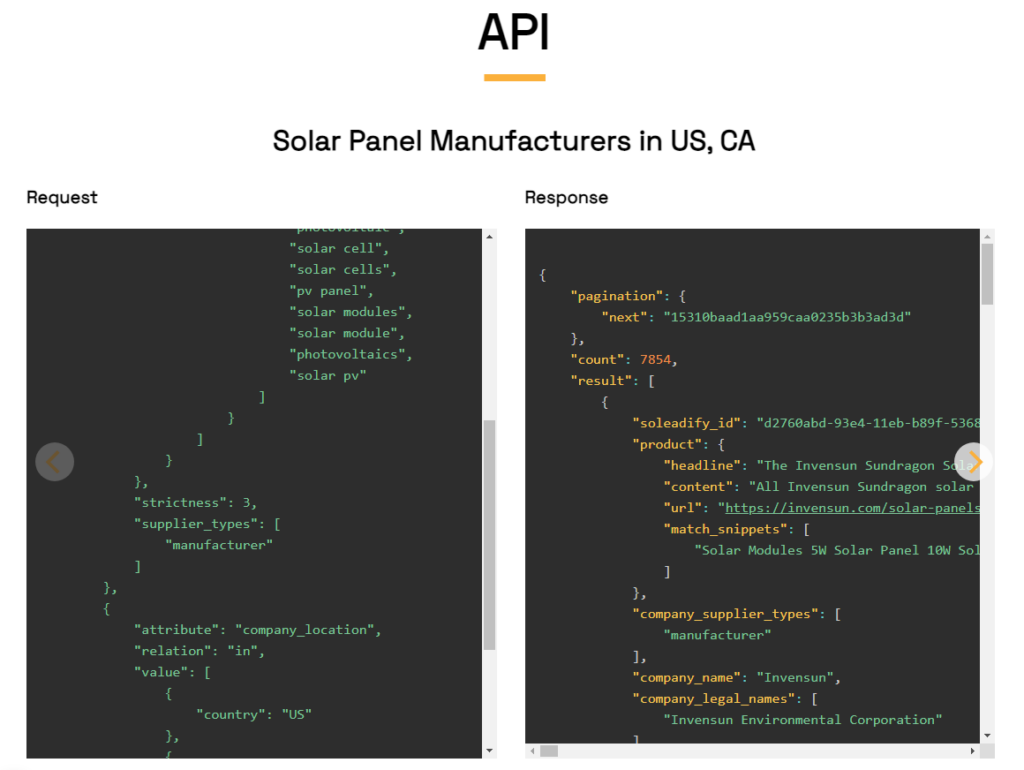
Source: Veridion
Our system will then look at your query and the included criteria to give you a list of the best suppliers matching it, saving you weeks of manual searching.
Using automation tools like Veridion and the others mentioned can greatly simplify those tedious procurement tasks, helping your team focus on achieving goals rather than data-crunching.
Your procurement function is only as good as the team behind it.
That’s why focusing on building a strong team is essential for achieving your goals.
Of course, creating a strong team starts with hiring the right people—those with the right skills, knowledge, and experience.
But how can you invest in your current team?
Let’s explore some options.
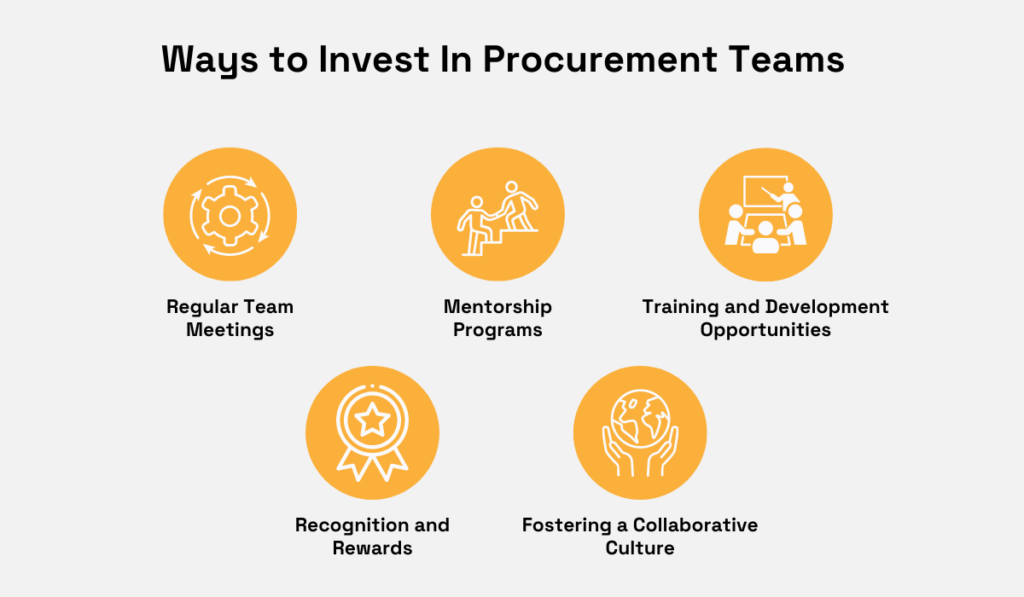
Source: Veridion
Regular team meetings and mentorships are great for keeping everyone aligned and motivated.
These practices provide a platform for sharing progress, addressing challenges, supporting newer recruits, and collectively brainstorming solutions.
Also, consider investing in training and development opportunities.
For example, you can enroll the whole team in specialized training programs from reputable institutions, like the CIPS Qualifications Programme.

Source: CIPS
The Chartered Institute of Procurement & Supply (CIPS) offers a rich, expert-led curriculum that covers many aspects of procurement and supply chain management through a flexible program that can improve your team’s expertise and credibility in the field.
Another valuable investment is sending your team to procurement and supply conferences.
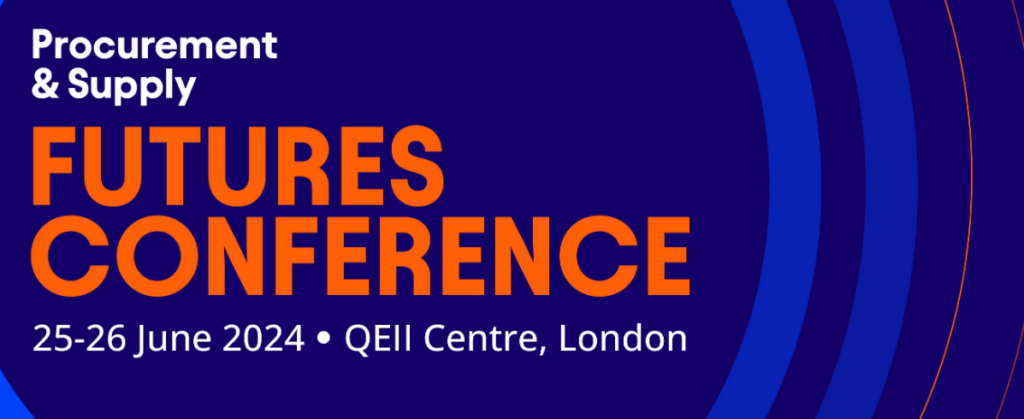
Source: CIPS
These conferences and training programs serve a dual purpose.
Not only are they an excellent learning opportunity, but they also support the creation of a collaborative culture within your team.
Team members who learn and grow together often develop stronger bonds and work more effectively as a unit.
This, in turn, encourages innovation, promotes problem-solving, and uses the combined strength of team members to get better procurement outcomes.
By investing in your team’s development, fostering collaboration, and staying current with industry trends, you’ll prepare them to meet and exceed your procurement objectives.
While we’re on the topic of skill-building, it is critical for you and your team to be skilled at negotiating.
Specifically, we’re talking about the ability to negotiate the most favorable terms with suppliers and secure the best possible price, quality, and delivery time, as well as anything else that aligns with your procurement goals.
One important concept in negotiation is leverage.
Simply put, leverage is your bargaining power—the ability to influence a supplier’s willingness to make concessions during negotiations.
This can come from various sources, such as having multiple supplier options, large order volumes, or a strong reputation in the market.
To illustrate, if you have multiple suppliers offering similar products, you have more leverage to negotiate a better price, as you can always take your business elsewhere.
Conversely, if you rely on a single supplier, they have more leverage, as you don’t really have any alternatives.
However, leverage doesn’t mean tricking suppliers or viewing them as adversaries to be defeated.
In fact, successful negotiation focuses on building a mutually beneficial relationship where both parties are committed to achieving their mutual goals.
Take a look at the graph below, which illustrates the levels of commitment between buyers and suppliers.

Source: CIPS
What you’re really aiming for are collaborative or co-destiny relationships which are high up on the graph.
Building these relationships with suppliers involves a shift in negotiation from a transactional to a partnership-oriented approach.
This means that negotiations should be transparent and focused on the following:
Through improving your negotiation skills and building these collaborative relationships, you’re setting up a win-win situation.
Both you and your suppliers benefit, and it drives long-term value for your organization.
At the very beginning of this article, we discussed the importance of setting clear goals.
Now, let’s go into Key Performance Indicators (KPIs), the metrics and measurements used to track progress towards these goals.
Tracking KPIs can fall within a practice called Benefits Management.
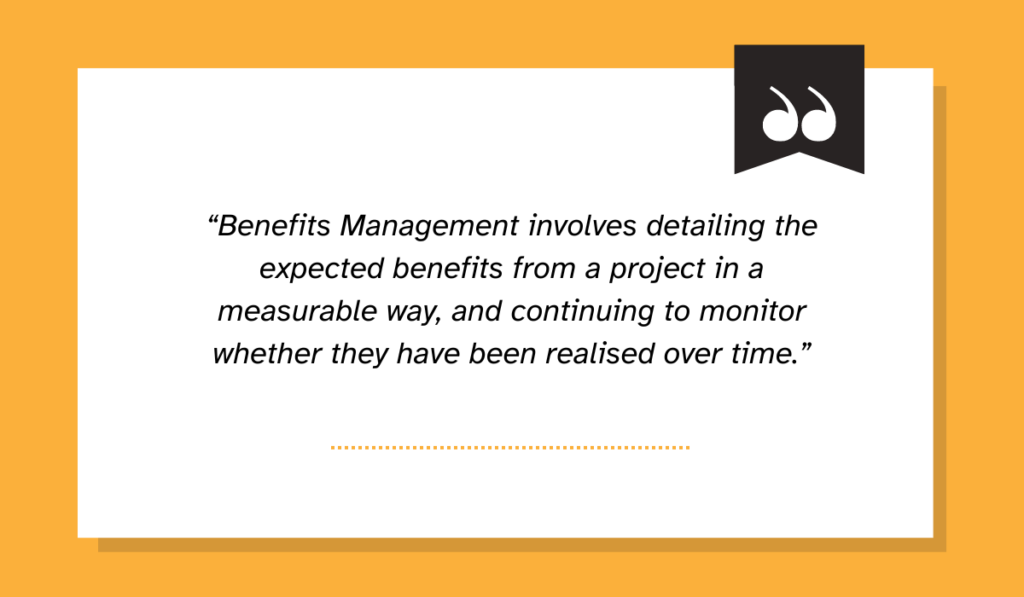
Illustration: Veridion / Quote: OECD
In short, a benefit is a measurable improvement resulting from a desired outcome by one or more stakeholders.
According to OECD, procurement teams should clearly define and monitor these benefits and link them to your procurement goals.
For measuring progress, we’ve outlined some key KPIs in our article dedicated to the topic, with some of the more common ones illustrated below.
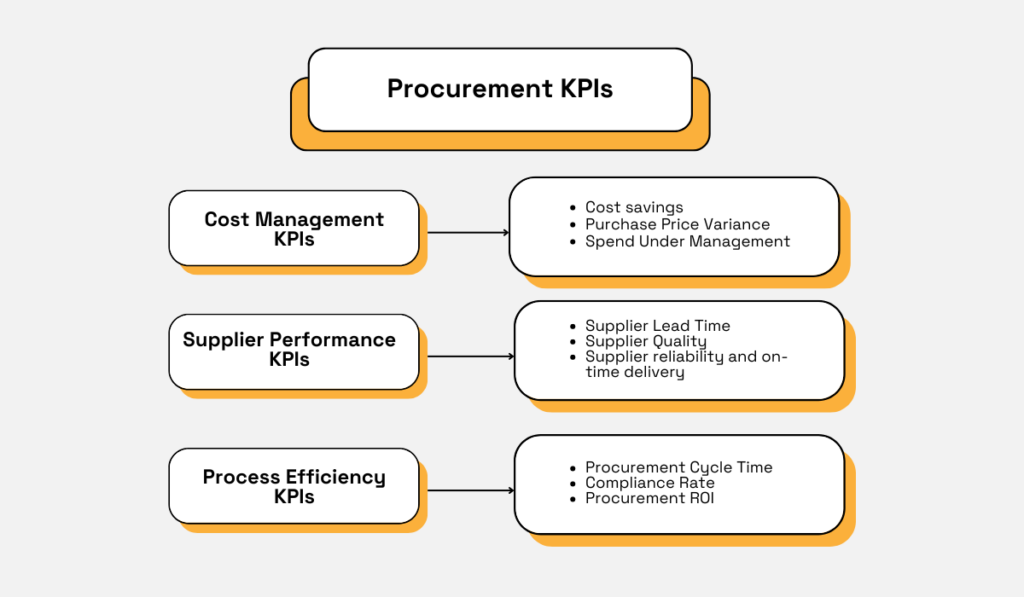
Source: Veridion
These measurements can then be used to benchmark against industry standards or competitors and see how you compare.
Alternatively, you can use these KPIs to track your team’s progress over time.
In doing so, you might discover a bottleneck in the approval process, where requests get stuck waiting for multiple signatures.
Conversely, you might find that your supplier selection process is highly efficient, thanks to automation tools.
You would then focus on streamlining the approval process, maybe by implementing electronic signatures, while studying the supplier selection process to see if those efficiencies can be replicated elsewhere.
You can essentially make incremental adjustments based on your KPI data and steadily work toward that 20% reduction.
Overall, monitoring your KPIs is crucial for assessing whether you’re moving toward your procurement goals and helping you make data-driven improvements.
Finally, let’s talk about agility in procurement.
Achieving procurement goals in today’s world of unstable markets, supply chain disruptions, and geopolitical issues requires an agile approach.
This means being flexible, adaptable, and responsive to change.
Agile procurement emphasizes collaboration, continuous improvement, and rapid iteration.
It’s about breaking down large projects into smaller, more manageable chunks, and delivering value in short cycles.
This allows procurement teams to quickly adapt to changing circumstances and make adjustments as needed.
Compared to the traditional, linear approach to procurement, the differences are clear.
| Feature | Traditional Procurement | Agile Procurement |
| Planning | Upfront, detailed planning | Continuous planning and adaptation |
| Risk Management | Focus on risk avoidance | Proactive risk management and mitigation |
| Supplier Relationships | Transactional, based on contracts | Collaborative partnerships |
| Process | Sequential, with clearly defined phases | Iterative, with frequent feedback and adjustments |
| Response to Change | Slow, resistant | Fast, adaptive |
These characteristics of Agile offer many benefits for procurement, illustrated below.
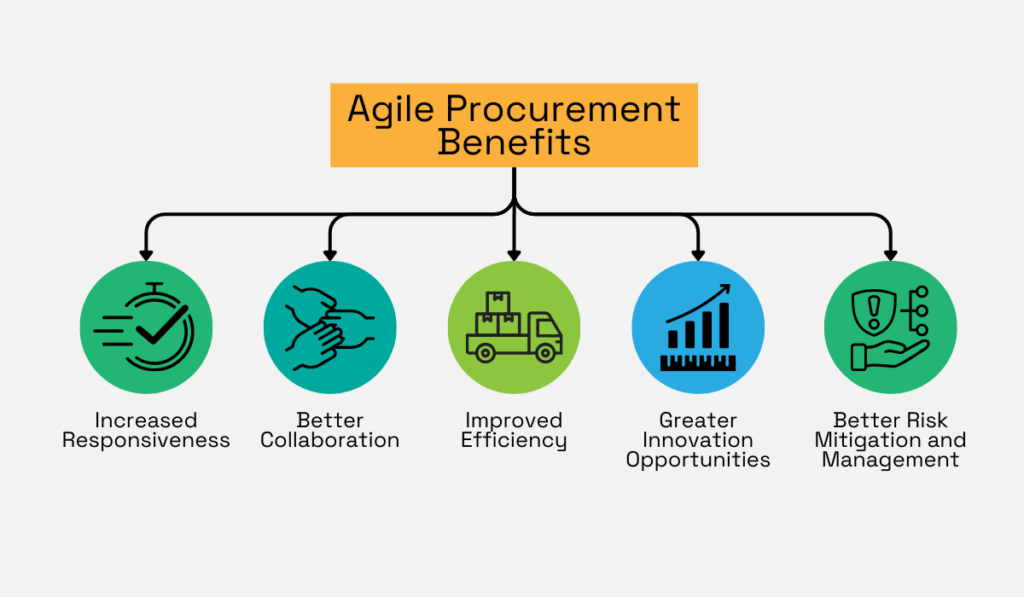
Source: Veridion
Through this approach, procurement teams can be more responsive and efficient while achieving better risk mitigation.
This means they can adjust their strategies quickly when faced with unexpected changes, preventing failed goals due to external factors.
Instead of sticking rigidly to a plan that may no longer be relevant, agile teams can pivot and find new ways to achieve their objectives.
Goals can be met more quickly, too.
Just take a look at this summary for a case study of CKW Group.
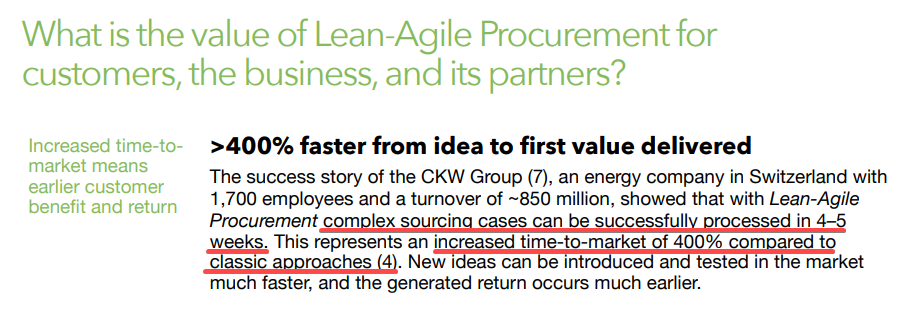
Source: Lean-Agile Procurement
You might be wondering what made adopting Agile lead to 400% faster time-to-market.
The agile approach used by CKW involved a 2-day workshop where they worked directly with three vendors to create an agile contract.
This format sped up decision-making and allowed them to produce working product increments by the end of each day.
The team was able to start implementation right after the workshop, cutting the time from the decision to contract from 1-2 months down to just one day.
This alone goes to show that adopting Agile can really speed things up.
As we’ve seen with CKW Group, you can cut down on sourcing time, work better with suppliers, and ensure faster goal achievement.
That wraps up our guide to boosting your game in order to achieve your procurement goals.
We’ve covered setting clear, measurable objectives, embracing new technologies, building a strong Agile team, monitoring KPIs, and the importance of negotiation skills.
Our hope is that you feel empowered and equipped to apply these tips in your daily work, leading to more efficient procurement outcomes.
You don’t have to change everything overnight. The key to success lies in consistent and continuous improvement.
Keep pushing forward, and you’ll see the benefits unfold, transforming your procurement efforts into a source of strength for your organization.